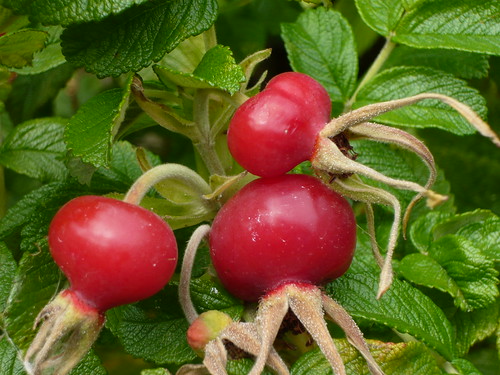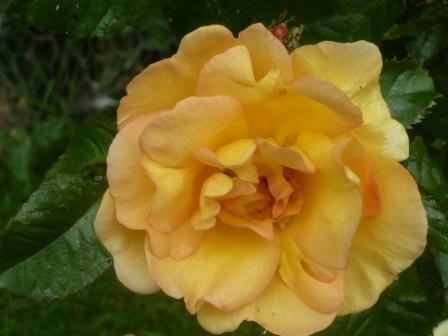Rose Hips for Gardens & Coughs

‘Three cheers for Rose hips’
Roses produce hips to carry seeds if we do not deadhead. The colour of the hips (aka heps, haws, Pixie Pears or even Pig’s Noses) vary with some strong reds and bright orange varieties. The wild varieties and species rose are often better hip producers as other roses have been bred for floral purposes. Tip do some research when buying roses to get good hips.

Good Hip Roses
- Rosa Rugarosa are grown for the hips that follow the flowers. They make a good hedge with masses of small bristly thorns up to 6 feet high. Rugarosa Alba are fragrant white flowers of heavily scented large white flowers June to September followed by large orange-red hips early autumn .
- The climbing Rose Francis E. Lester has large bunches of small blooms with a strong fragrance. This is followed by masses of small orange hips in autumn.
- Rosa ‘Geranium’Â is a large, vigorous shrub with arching branches and dark-green leaves. In summer, it produces red flowers with prominent yellow stamens, followed by bright-red, long hips in autumn.
- Rose Macrophylla has clear pink flowers followed by long bristly, flagon-shaped hips.
- Hips help attract wild birds and feed them through winter.
- Many hips from wild roses are colourful and can be used in flower arrangements.
- Fruiting varieties like ‘Buff Beauty’ ‘Felicia’ and ‘Penelope’ are usually edible and pleasantly sweet, especially if you wait until the frost has concentrated their sugars.
- Hips are decorative and can look spectacular during winter with a rime of frost.
- Rose hips are made into syrup for vitamin C and here are some other recipes.
HT roses seem to produce more boring hips.
Rosehip Syrup, Tea and Cordial
Before setting out for school in the 1950’s I remember taking a spoonful of Rosehip syrup. The vitamin C must have done me some good as I am still here.
Rosehip Syrup Recipes
- Crush about 2lbs rosehips and put into 3 pints boiling water.
- Bring back to boil, remove from heat and let stand for 10 mins.
- Strain through jellybag. When it ceases to drip, return to pan with another 1½ pints boiling water.
- Pour into a clean pan, reduce by boiling until juice measures 1½ pints.
- Add 1lb sugar.
- Stir over gentle heat until sugar dissolves and boil for 5 minutes.
- Pour into hot bottles and seal.
- With thanks to Hedgerow recipes see
Other Uses for Rosehips
- The real reason for Rosehips is to produce pollinated seed from which to grow more roses.
- Rosehips are decorative particularly the Rugusa varieties. It is worth growing them to feed birds and show a bit of autumn colour. Rosa canina is noted for its medicinal qualities.
- Returning to the 1950’s I remember opening Rosehips and pushing the seed and pulp down the shirt of friends. This was intended to cause itching beyond endurance. Perhaps if I breed a new rose I will call it Itchy and Scratchy
- Rosehips are edible the tastiest may be from the Rugusa variety. They contain more vitamin C than an orange, and are high in vitamins, B A, and E,
- Use in wine, jellies jams or as flavouring.


